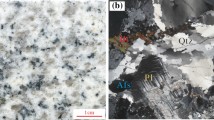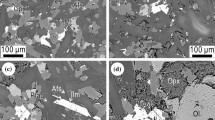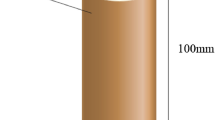Abstract
A new, high-efficiency technology for fracturing and breaking rocks is required. Due to various advantages including high efficiency, energy-saving, and having no secondary pollution, the technology of microwave-induced fracturing of hard rock has been considered as a potential method for rock fracturing and breaking. Aiming at the realisation of two engineering applications: microwave-assisted mechanical rock breaking and stress release from rock masses in deep underground engineering works to prevent geological disasters caused by high-stress concentrations such as rockbursts, a novel (open-type) microwave-induced fracturing apparatus (OMWFA) for fracturing hard rocks was developed. On this basis, the two modes of microwave-induced subsurface fracturing and microwave-induced borehole fracturing of hard rocks were proposed. Due to removal of the restraint of the microwave cavity, OMWFA can be used to fracture large-size rock samples and engineering-scale rock masses. Using the apparatus, the fracturing effects of the two fracturing modes on different dimensions of cuboidal basalt samples were investigated. By combining the microwave-induced fracturing apparatus with a press machine to explore the influence of unidirectional stress on the fracturing effect of microwave treatment on basalt. Moreover, field tests were carried out on rock masses encountered in underground engineering works at Baihetan Hydropower Station in Sichuan Province, China, and the fracturing effects were evaluated by applying a digital borehole televiewer and conducting acoustic wave testing. The results show that the apparatus had favourable fracturing effects on the subsurface and borehole samples of basalt. When no stress was applied, the cracks radially expanded from the approximate centre of the radiant surface and unidirectional stress promoted fracturing. The number and depth of cracks increased with prolonged microwave exposure. After microwave treatment, the P-wave velocity of the samples declined, and the longer the microwave exposure, the more significant the reduction in P-wave velocity was. The results of field test reveal that borehole fracturing can exhibit a favourable effect around boreholes. The sound velocity around the borehole and between the boreholes both declined to some extent. Microwave-induced hard rock fracturing offers guiding significance to those exploring and developing new rock breaking and tunnelling methods, and generally enhances construction safety in deep underground engineering works.















Similar content being viewed by others
Abbreviations
- a, b, c, and d :
-
Constants
- w :
-
Width of the cutter edge
- D :
-
Cutter diameter
- L :
-
Disc cutter rolling length
- P :
-
Penetration per revolution
- CAI:
-
Cerchar abrasivity index of the rock surface
- F n :
-
Normal force applied by the disc cutter
- σ c :
-
Uniaxial compressive strength
- σ τ :
-
Direct shear strength
- σ PTL :
-
Point load strength index
- θ :
-
One-half of the wedge-shaped disc cutter edge angle
References
Adams GR, Jager AJ, Roering C (1981) Investigations of rock fracture around deep-level gold mine stopes. In: Proc 22nd US symposium on rock mechanics, Cambridge, pp 213–218
Batchelor AR, Jones DA, Plint S, Kingman SW (2016) Increasing the grind size for effective liberation and flotation of a porphyry copper ore by microwave treatment. Miner Eng 94(8):61–75
Boniface A (2000) Tunnel boring machine performance in basalts of the Lesotho formation. Tunn Undergr Space Technol 15(1):49–54
Buttress AJ, Binner E, Yi C, Palade P, Robinson JP, Kingman SW (2016) Development and evaluation of a continuous microwave processing system for hydrocarbon removal from solids. Chem Eng J 283(1):215–222
Cheng YL, Zhong J, Ji ZY, Mei YB (2018) Geological adaptative design method and application of TBM cutterhead. Chin J Mech Eng 54(1):1–9 (in Chinese)
Deliormanlı AH (2012) Cerchar abrasivity index (CAI) and its relation to strength and abrasion test methods for marble stones. Constr Build Mater 30(5):16–21
Duan SQ, Feng XT, Jiang Q, Liu GF, Pei SF, Fan YL (2017) In situ observation of failure mechanisms controlled by rock masses with weak interlayer zones in large underground cavern excavations under high geostress. Rock Mech Rock Eng 50(12):1–29
Entacher M, Lorenz S, Galler R (2014) Tunnel boring machine performance prediction with scaled rock cutting tests. Int J Rock Mech Min Sci 70:450–459
Farmer IW, Glossop NH (1980) Mechanics of disc cutter penetration. Tunn Tunn 12(6):22–25
Feng GL, Feng XT, Chen BR, Xiao YX (2015a) Microseismic sequences associated with rockbursts in the tunnels of the Jinping II hydropower station. Int J Rock Mech Min Sci 80(12):89–100
Feng GL, Feng XT, Chen BR, Xiao YX, Yu Y (2015b) A microseismic method for dynamic warning of rockburst development processes in tunnels. Rock Mech Rock Eng 48(5):2061–2076
Feng XT, Yu Y, Feng GL, Xiao YX, Chen BR, Jiang Q (2016) Fractal behaviour of the microseismic energy associated with immediate rockbursts in deep, hard rock tunnels. Tunn Undergr Space Technol 51(1):98–107
Ferrari-john RS, Batchelor AR, Katrib J, Dodds C, Kingman SW (2016) Understanding selectivity in radio frequency and microwave sorting of porphyry copper ores. Int J Miner Process 155(10):64–73
Filbà M, Salvany JM, Jubany J, Carrasco L (2016) Tunnel boring machine collision with an ancient boulder beach during the excavation of the Barcelona city subway L10 line: a case of adverse geology and resulting engineering solutions. Eng Geol 200:31–46
Hartlieb P, Grafe B (2017) Experimental study on microwave assisted hard rock cutting of granite. BHM Berg Hüttenmännische Monatshefte 162(2):1–5
Hartlieb P, Leindl M, Kuchar F, Antretter T, Moser P (2012) Damage of basalt induced by microwave irradiation. Miner Eng 31(5):82–89
Hartlieb P, Toifl M, Kuchar F, Meisels R, Antretter T (2016) Thermo-physical properties of selected hard rocks and their relation to microwave-assisted comminution. Miner Eng 91(5):34–41
Hartlieb P, Kuchar F, Moser P, Kargl H, Restner U (2018) Reaction of different rock types to low-power (3.2 kW) microwave irradiation in a multimode cavity. Miner Eng 118:37–51
Hassani F, Nekoovaght P (2011) The development of microwave assisted machineries to break hard rocks. In: Proceedings of the 28th international symposium on automation and robotics in construction (ISARC), Seoul, pp 678–684
Hassani F, Nekoovaght P (2012) The use of microwave to contribute to breakage of rocks. In: 2nd South American symposium on rock excavations, San José
Hassani F, Ouellet J, Radziszewski P, Nokken M, Nekoovaght P (2007) Exploring microwave assisted drilling. In: Planetary and terrestrial mining sciences symposium (PTMSS), Montreal
Hassani F, Ouellet J, Radziszewski P, Nokken M, Nekoovaght P (2008) Microwave assisted drilling and its influence on rock breakage. In: International symposium of rock mechanics. Proceedings of 5th Asian rock mechanics symposium, Maturitas: ISRM-sponsored international symposium, pp 87–104
Hassani F, Nekoovaght PM, Radziszewski P, Waters KE (2011) Microwave assisted mechanical rock breaking. In: Proceedings of the 12th ISRM international congress on rock mechanics. International Society for Rock Mechanics, Beijing, pp 2075–2080
Hassani F, Nekoovaght PM, Gharib N (2016) The influence of microwave irradiation on rocks for microwave-assisted underground excavation. J Rock Mech Geotechn Eng 8(1):1–15
Jain P, Naithani A, Singh T (2014) Performance characteristics of tunnel boring machine in basalt and pyroclastic rocks of Deccan traps—a case study. J Rock Mech Geotech Eng 6(1):36–47
Jiang Q, Fan YL, Feng XT, Li Y, Pei SF, Liu GF (2017) Unloading break of hard rock under high geo-stress condition: inner cracking observation for the basalt in the Baihetan’s underground powerhouse. Chin J Rock Mechan Eng 36:1076–1087 (in Chinese)
Jones DA, Lelyveld TP, Mavrofidis SD, Kingman SW, Miles NJ (2002) Microwave heating applications in environmental engineering—a review. Resour Conserv Recycl 34(2):75–90
Kingman SW, Rowson NA (1998) Microwave treatment of minerals—a review. Miner Eng 11(11):1081–1087
Kingman SW, Corfielf GM, Rowson NA (1998) Effects of microwave radiation upon the mineralogy and magnetic processing of a massive Norwegian ilmenite ore. Magn Electr Sep 9:131–148
Kingman SW, Vorster W, Rowson NA (2000) The influence of mineralogy on microwave assisted grinding. Miner Eng 13(3):313–327
Kingman SW, Jackson K, Bradshaw SM, Rowson NA, Greenwood R (2004a) An investigation into the influence of microwave treatment on mineral ore comminution. Powder Technol 146(3):176–184
Kingman SW, Jackson K, Cumbane A, Bradshaw SM, Rowson NA, Greenwood R (2004b) Recent developments in microwave-assisted comminution. Int J Miner Process 74(1):71–83
Konicek P, Konecny P, Ptacek J (2011a) Destress rock blasting as a rockburst control technique. In: International congress on rock mechanics of the international society for rock mechanics. CRC Press, pp 1221–1226
Konicek P, Saharan MW, Mitri H (2011b) Destress blasting in coal mining—state-of-the-art review. Proc Eng 26(4):179–194
Li X, Yuan D (2018) Creating a working space for modifying and maintaining the cutterhead of a large-diameter slurry shield: a case study of Beijing railway tunnel construction. Tunn Undergr Space Technol 72:73–83
Li SJ, Feng XT, Li ZH, Chen BR, Zhang CQ, Zhou H (2012) In situ monitoring of rockburst nucleation and evolution in the deeply buried tunnels of Jinping II hydropower station. Eng Geol 137–138(6):85–96
Li YH, Lu GM, Feng XT, Zhang X (2017) The influence of heating path on the effect of hard rock fragmentation using microwave assisted method. Chin J Rock Mech Eng 36(6):1460–1468 (in Chinese)
Lightfoot N, Goldbach OD, Kullmann DH, Toper AZ (1996) Rockburst control in the South African deep level gold mining industry. In: Proc. 2nd. North American rock mechanics symposium. NARMS, pp 295–303
Lindroth DP, Morrell RJ, Blair JR (1991) Microwave assisted hard rock cutting. US Patent, 5003144
Lu GM (2018) Experimental study on the microwave fracturing of hard rock. Northeastern University, Shenyang (in Chinese)
Lu GM, Li YH, Hassani F, Zhang X (2016) Review of theoretical and experimental studies on mechanical rock fragmentation using microwave-assisted approach. Chin J Geotech Eng 38(8):1497–1506 (in Chinese)
Lu GM, Li YH, Hassani F, Zhang X (2017) The influence of microwave irradiation on thermal properties of main rock-forming minerals. Appl Therm Eng 112(2):1523–1532
Lu GM, Feng XT, Li YH, Hassani F, Zhang X (2019) Experimental investigation on the effects of microwave treatment on basalt heating, mechanical strength, and fragmentation. Rock Mech Rock Eng. https://doi.org/10.1007/s00603-019-1743-y
Mazaira A, Konicek P (2015) Intense rockburst impacts in deep underground construction and their p. Revue Canadienne De Géotechnique 52
Mitri HS, Saharan MW (2005) Destress blasting in hard rock mines—a state-of-the-art review. Cim Bull 98(1091):413–420
Monti T, Tselev A, Udoudo O, Ivanov IN, Dodds C, Kingman SW (2016) High-resolution dielectric characterization of minerals: a step towards understanding the basic interactions between microwaves and rocks. Int J Miner Process 151(10):8–21
Nekoovaght P, Hassani F (2014) The influence of microwave radiation on hard rocks as in microwave assisted rock breakage applications. In: Rock engineering and rock mechanics: structures in and on rock masses, Boca Raton, pp 195–198
Nekoovaght P, Gharib N, Hassani F (2014a) Numerical simulation and experimental investigation of the influence of 2.45 GHz microwave radiation on hard rock surface. In: ISRM international symposium—8th Asian rock mechanics. International Society for Rock Mechanics, Sapporo
Nekoovaght P, Gharib N, Hassani F (2014b) Microwave assistance positive influence on rock breakage in space mining applications. In: 65th international astronautical congress. International Astronautical Federation, Toronto, pp 1–7
Nishitake S (1989) Earth pressure balanced shield machine to cope with boulders. Int J Rock Mech Min Sci Geomech Abstr 26(6):552–572
Osepchuk JM (1984) A history of microwave heating applications. IEEE Transon Microw Theory Tech 32(9):1200–1224
Peinsitt T, Kuchar F, Hartlieb P, Moser P, Kargl H, Restner U, Sifferlinger N (2010) Microwave heating of dry and water saturated basalt, granite and sandstone. Int J Min Miner Eng 2(1):18–29
Ramezanzadeh A, Rostami J, Kastner R (2004) Performance prediction models for hard rock Tunnel Boring Machines. In: Proceedings of sixth Iranian tunneling conference, Tehran, Iran
Rostami J (2016) Performance prediction of hard rock tunnel boring machines (TBMs) in difficult ground. Tunn Undergr Space Technol 57(6):173–182
Satish H, Ouellet J, Raghavan V, Radziszewski P (2006) Investigating microwave assisted rock breakage for possible space mining applications. Min Technol 115(1):34–40
Suana M, Peters T (1982) The Cerchar Abrasivity Index and its relation to rock mineralogy and petrography. Rock Mech Rock Eng 15(1):1–8
Tian J, Lu GM, Feng XT, Li YH, Zhang X (2019) Experimental study on the microwave sensitivity of main rock-forming miner-als. Rock Soil Mech 40(6):1–9 (in Chinese)
Toifl M, Hartlieb P, Meisels R, Antretter T, Kuchar F (2017) Numerical study of the influence of irradiation parameters on the microwave-induced stresses in granite. Miner Eng 103–104(4):78–92
Vorster W, Rowson NA, Kingman SW (2001) The effect of microwave radiation upon the processing of Neves Corvo copper ore. Int J Miner Process 63(1):29–44
Whittles DN, Kingman SW, Reddish DJ (2003) Application of numerical modelling for prediction of the influence of power density on microwave-assisted breakage. Int J Miner Process 68(1):71–91
Wijk G (1992) A model of tunnel boring machine performance. Geotechn Geol Eng 10(1):19–40
Xia YM, Ouyang T, Zhang XM, Luo DZ (2012) Mechanical model of breaking rock and force characteristic of disc cutter. J Cent S Univ 19(7):1846–1858
Xia YM, Zhang K, Liu JS (2015) Design optimization of TBM disc cutters for different geological conditions. World J Eng Technol 03(4):218–231
Xia YM, Lin LK, He F, Wu D, Li ZG, Ji ZY (2018) Geological adaptability design method of disc cutter ring. Chin J Mech Eng 54(1):10–17 (in Chinese)
Zheng YL, Zhang QB, Zhao J (2017) Effect of microwave treatment on thermal and ultrasonic properties of gabbro. Appl Therm Eng 127:359–369
Acknowledgements
Financial support for this work by the National Natural Science Foundation of China under Grant No. 41827806 and the China Postdoctoral Science Foundation under Grant No. 2018M642958 is both greatly appreciated.
Author information
Authors and Affiliations
Corresponding author
Additional information
Publisher’s Note
Springer Nature remains neutral with regard to jurisdictional claims in published maps and institutional affiliations.
Rights and permissions
About this article
Cite this article
Lu, GM., Feng, XT., Li, YH. et al. The Microwave-Induced Fracturing of Hard Rock. Rock Mech Rock Eng 52, 3017–3032 (2019). https://doi.org/10.1007/s00603-019-01790-z
Received:
Accepted:
Published:
Issue Date:
DOI: https://doi.org/10.1007/s00603-019-01790-z




